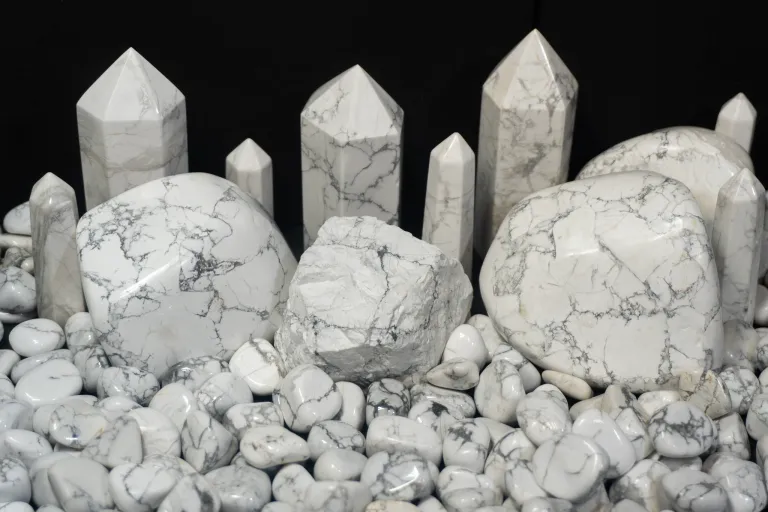
Appearance
The color of howlite is primarily white or grayish-white. Occasionally, it may have subtle differences, such as veining or streaks in various tones of gray, black, or brown. The luster of howlite usually ranges from vitreous (glassy) to dull, depending on the surface quality and finish. Typically, howlite is opaque, which means that light cannot travel through it. Howlite crystallizes in the monoclinic crystal system, which has one oblique axis and three uneven axes making up its crystal structure.
Geographical Distribution
Although howlite is most commonly found in Canada, it is also found in the United States, Mexico, Germany, and Russia, among other places.
History
Calcium borosilicate hydroxide is the main component of the mineral howlite. It bears Henry How’s name, a Canadian geologist and chemist who made the initial discovery of it in 1868 in Nova Scotia.
Howlite’s brilliant white color and ease of dyeing made it a popular alternative to more costly gemstones like coral and turquoise in the 19th century. It has been widely employed in the manufacturing of cabochons, beads, and other jewelry elements.
Howlite has become more well-known recently due to its distinctive look and broad range of applications in jewelry design.
Chemical Composition
Howlite is classified as a calcium borosilicate hydroxide based on its chemical makeup. Its chemical formula, Ca2B5SiO9(OH)5, is frequently written. Let’s dissect the formula’s constituent parts:
Calcium (Ca): Howlite’s makeup is essentially composed of calcium. It adds to the general composition and characteristics of the material.
Boron (B): Another important element included in howlite is boron. It affects the mineral’s properties and contributes to its chemical makeup.
Silicate (SiO4): The compound silicate is made up of silicon (Si) and oxygen (O). It is a basic component of numerous minerals, including howlite. The crystal structure is made up of silicate tetrahedral, which is made up of one silicon atom joined to four oxygen atoms.
Hydroxide (OH): One oxygen atom bound to one hydrogen atom makes up the hydroxide group (-OH). It also adds to the overall composition of howlite and is a part of its chemical formula.

Types
Natural Howlite:
Howlite that is discovered and extracted straight from its original geological formations is referred to as natural howlite. It is howlite in its purest form, holding onto all of its natural qualities. Canada is the main supplier of natural howlite, especially from sources in Nova Scotia.
Treated and Enhanced Howlite:
Because howlite is a porous and somewhat soft mineral, it can be enhanced and treated in a variety of ways. Coloring howlite is a common way to make it seem better or mimic other gemstones.
White Turquoise:
Howlite that has been dyed to mimic turquoise and is colored white or light-colored is traded under the term “white turquoise,” sometimes known as “white buffalo turquoise.”
Magnesite:
Howlite and magnesite are two minerals that are very similar in appearance. It has a porous texture and is frequently white or grayish-white in color. Although howlite and magnetite share superficial similarities, their chemical makeups are dissimilar.
Marble:
Howlite can occasionally be compared to white or grayish-white marble. Minerals such as dolomite or calcite make up the majority of the metamorphic rock known as marble. Its resilience and elegance make it a popular choice for sculpting and building.
Uses
Common uses for howlite include the following:
- Jewelry: A common gemstone used in jewelry-making is howlite. Its distinctive veining and porosity, combined with its white or grayish-white hue, make it a desirable option for beads, cabochons, pendants, and other jewelry elements. Howlite is a material that may be molded, polished, and used to make rings, bracelets, earrings, and necklaces.
- Ornamental Objects: Howlite is a popular choice for ornamental items because of its unique look and inherent attractiveness. It may be carved to make ornamental bowls, vases, sculptures, and figurines. Because howlite is porous, it can also be used as a decorative element for diffusing perfumes or essential oils.
- Beads and Craft Supplies: Natural and dyed howlite beads are frequently utilized in beaded jewelry designs. They provide artists and craftsmen options because they come in a variety of sizes and forms. Beaded bracelets, necklaces, and other crafts can be made with howlite beads.
- Cabochons and Cameos: Howlite is frequently cut into cabochons, which are polished, round-topped gemstones devoid of facets. You can set these cabochons into brooches, pendants, and rings. When used in cameo carvings, the veining and color variations of howlite can provide patterns that are both interesting and distinctive.
- Industrial Applications: Howlite can be utilized as a filler material in industrial applications because of its comparatively soft nature. It can be a part of casting materials, pottery, and ceramics.
- Gemstone Substitution: Howlite has been used to replace more costly gemstones like coral and turquoise. It is a good substitute because of its porous structure and white color, especially when tinted to seem like other gemstones.
Table





